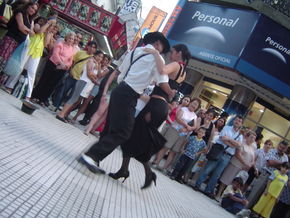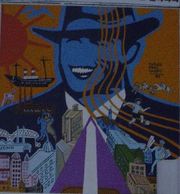| |
Tango
Music Sound
Tango
 Tango in the streets of
Buenos
Aires.
Tango in the streets of
Buenos
Aires.Tango is a
social
dance form that originated in
Buenos Aires, Argentina. The musical styles that evolved together with the dance
are also known as "tango".
Early tango was known as tango criollo or simply tango. Today,
there are many tango dance styles including Argentine tango, ballroom tango
(American and International styles), Finnish tango, Chinese tango, and vintage
tangos. The
Argentine tango is regarded as the "authentic" tango since it is closest to that
originally danced in Buenos Aires, Argentina.
Music and dance elements of tango are popular in activities related to
dancing, such as
figure skating, synchronized swimming, etc., because of its dramatic feeling and
rich opportunities for improvisation on the eternal topic of love.
History
The dance originated in lower-class districts of
Buenos Aires, during the late 19th century. The music derived from the fusion of
music from Europe, the South American Milonga, and African rhythms. The word
Tango seems to have first been used in connection with the dance in the 1890s.
Initially it was just one of the many dances, but it soon became popular
throughout society, as theatres and street barrel organs spread it from the
suburbs to the working-class slums, which were packed with hundreds of thousands
of European immigrants.
 Tango postcard, c. 1919
Tango postcard, c. 1919
In the early years of the twentieth century, dancers and orchestras from
Buenos Aires travelled to Europe, and the first European tango craze took place
in Paris, soon followed by London, Berlin, and other capitals. Towards the end
of 1913 it hit New York in the USA, and Finland.
In Argentina, the onset in
1929 of the Great Depression, and restrictions introduced after the overthrow of
the Hipólito Yrigoyen government in 1930 caused Tango to decline. Its fortunes
were reversed as tango again became widely fashionable and a matter of national
pride under the government of Juan Perón. Tango declined again in the 1950s with
economic depression and as the military dictatorships banned public gatherings,
followed by the popularity of Rock and Roll. The dance lived on in smaller
venues until its revival in the 1980s following the opening in Paris of the show
Tango Argentino and the Broadway musical Forever Tango.
Tango styles
There are a number of styles of tango:
-
Argentine Tango
- Tango Canyengue
- Tango Liso
- Salon Tango
- Tango Orillero
- Tango Milonguero (Tango Apilado)
- Tango Nuevo
- Vals (the tango version of waltz)
-
Milonga (a related dance that has a faster tempo)
- Show Tango (also known as Fantasia)
- Ballroom Tango, see
Ballroom dance
- American Style
- International Style
Ballroom tango
 Ballroom tango illustration, 1914
Ballroom tango illustration, 1914
Ballroom tango, divided in recent decades into the "International" (English)
and "American" styles, has descended from the tango styles that developed when
the tango first went abroad to Europe and America. The dance was simplified,
adapted to the preferences of conventional ballroom dancers, and incorporated
into the repertoire used in International Ballroom dance competitions. English
Tango was first codified in October
1922, when it was proposed that it should only be danced to modern tunes,
ideally at 30 bars per minute (i.e. 120 beats per minute - assuming a 4/4 measure).
Subsequently the English Tango evolved mainly as a highly competitive
competitive dance, while the American Tango evolved as an unjudged
social
dance with an emphasis on leading and following skills. This has led to some
principal distinctions in basic technique and style. Nevertheless there are
quite a few competitions held in the American style, and of course mutual
borrowing of technique and dance patterns happens all the time.
Ballroom tangos also use different music and styling from Argentine tangos,
with more staccato movements and the characteristic "head snaps". The head snaps
are totally foreign to Argentine tango.
Technique comparison
The ways that steps are taken in tango are quite different in ballroom versus
Argentine tango. Ballroom tango does not use gliding steps but instead uses
staccato steps. Teachers sometimes call out the steps as SLOW SLOW QUICK QUICK
SLOW, where the SLOW steps are better described as QUICK-HOLD as the dancer
rushes to make a step and then holds it as long as possible before rushing to
make the next step. That is what gives the staccato action of the steps. This is
an attempt to match the staccato accents that always appear in ballroom tango
music.
In ballroom tango the feet move before the whole body weight is moved, in
contrast to Argentine tango where the body center starts to move and is then
supported by the movement of the feet.
Other forms of tango, including Chinese tango and Argentine tango, use more
gliding steps that match the music which tends to be romantic and less staccato.
The basic position is a
closed position similar to that of other kinds of
ballroom dance. In Argentine Tango, the "close embrace" with full upper body
contact is often used. In Ballroom tango, the "close embrace" involves close
contact, too, but the contact is with the hips and upper thighs and not
the upper torso. In Argentine Tango, the ball of the foot may be placed first.
Alternately, the dancer may take the floor with the entire foot in a cat-like
manner. In the International style, "heel leads" (stepping first onto the heel,
then the whole foot) are used for forward steps. Ballroom tangos, including
American and International, are based mainly on the movement of the feet across
the floor, while the Argentine Tango includes various other moves such as the
gancho (hooking one's leg around one's partner's leg), the parada (in
which the leader puts his foot against the follower's foot), the arrastre
(in which the leader appears to drag the follower's foot), and several kinds of
sacada (in which the leader displaces the follower's leg, by stepping
into her space).
Argentine Tango is not danced in a rigid dance position, or "frame" but
inside an embrace, known as the abrazo. The embrace can be very close,
somewhat open, or offset in a "V" position. One style that has gained popularity
within the past ten years is the "milonguero" style, characterized by a very
close embrace, small steps, and syncopated rhythmic footwork. It is based on the
petitero or caquero style of the crowded downtown clubs of the
'50s. In contrast, the tango that originated in the family clubs of the suburban
neighborhoods (Villa Urquiza/Devoto/Avellaneda etc.) emphasizes long elegant
steps, and complex figures. In this case the embrace may be allowed to open
briefly, to permit execution of the complicated footwork. The complex figures of
this style became the basis for the theatrical-performance style of Tango seen
in the touring stage shows. For stage purposes, the embrace is often very open,
and the complex footwork is augmented with gymnastic lifts, kicks, and drops.
A newer style sometimes called "Nuevo Tango" has been popularized in recent
years by a younger generation of dancers and involves endless creativity in
steps. The embrace is often quite open and very elastic, permitting a large
variety of very complex figures. These dancers often enjoy dancing to rhythmic
jazz- or techno-inspired music, in addition to more traditional tango
compositions. Related groups preferring the identifier "Neo-Tango" dance almost
exclusively to "Alternative" musical genres.
Trivia
 Carlos Gardel, mural painting by Carlos Páez Vilaró
Carlos Gardel, mural painting by Carlos Páez Vilaró
For 1978
FIFA World Cup in Argentina Adidas designed
a ball and named it Tango[1]
likely a tribute to the host country of the event. This design was also used in
1982 FIFA World Cup in Spain as Tango Málaga[2],
and in 1984 and 1988 European Football Championships in France and West Germany.
Tango in film
Argentine tango is the main subject in these films:
The Tango Bar (1988), starring Raúl Juliá
The Tango Lesson (1997), starring Sally Potter and Pablo Verón, directed by
Sally Potter
Tango (1998), starring Cecilia Narova and Mía Maestro, directed by Carlos
Saura
Assassination Tango (2002), starring Robert Duvall, Rubén Blades and Kathy
Baker, directed by Robert Duvall
A number of films show ballroom tango in several scenes, such as:
The Four Horsemen of the Apocalypse (1921), starring Rudolph Valentino
and Alice Terry, directed by Rex Ingram.
Last Tango in Paris (1972), starring Marlon Brando and Maria Schneider,
directed by Bernardo Bertolucci.
The World's Greatest Lover (1977), starring Gene Wilder (who also directed),
Carol Kane and Dom DeLuise.
Never Say Never Again (1983), starring Sean Connery and Kim Basinger,
directed by Irvin Kershner.
Scent of a Woman (1992), Al Pacino as blind Colonel dances Argentine Tango.
Strictly Ballroom (1992), directed by Baz Luhrmann
Addams Family Values (1993), Raul Julia and Anjelica Huston dance a tango so
sensual that it makes all the champagne bottles in the nightclub pop their
corks.
Schindler's List (1993), starring Liam Neeson
True Lies (1994), starring Arnold Schwarzenegger and Jamie Lee Curtis,
directed by James Cameron
Happy Together (1997), directed by Wong Kar-wai
Moulin Rouge! (2001), featuring Ewan McGregor and "El Tango de Roxanne"
Le Tango Des Rashevski (2002)
Chicago (2002), starring Renée Zellweger, Catherine Zeta-Jones, and Richard
Gere, directed by Rob Marshall.
Shall We Dance (2004), starring Richard Gere, Jennifer Lopez and Susan
Sarandon, directed by Peter Chelsom.
Mr. & Mrs. Smith (2005), starring Brad Pitt and Angelina Jolie, directed by
Doug Liman.
Rent (2005) had Anthony Rapp and Tracie Thoms perform a semi-elaborate
ballroom tango in the song "Tango:Maureen" to describe their emotional
relations and issues over a promiscious girl they both dated.
Take the Lead (2006), starring Antonio Banderas, directed by Liz Friedlander
External links
Home | Up | Tango | Waltz
Music Sound, v. 2.0, by MultiMedia
This guide is licensed under the GNU
Free Documentation License. It uses material from the Wikipedia.
|
|







